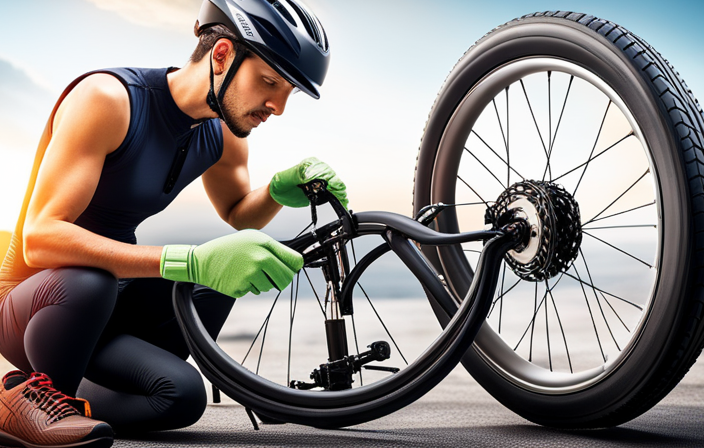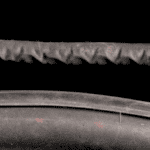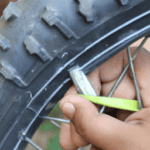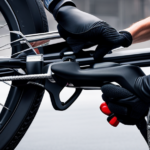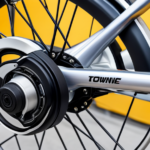Replacing the inner tube on your electric bike can be a simple yet essential skill to possess. In this guide, I will provide you with the step-by-step process to efficiently and effectively replace the inner tube, ensuring your bike is back on the road in no time.
From gathering the necessary tools to reattaching the wheel, each step will be explained in precise detail, ensuring a successful and hassle-free inner tube replacement.
Let’s dive in and get your electric bike rolling smoothly once again.
Key Takeaways
- Proper wheel reattachment and securing is essential for the safety and functionality of the electric bike.
- Conducting a post-repair inspection is crucial to identify any potential issues or problems and ensure a safe riding experience.
- Regularly checking and maintaining the tire pressure helps prevent tire damage and improves the overall ride quality.
- Testing the bike on a smooth surface and checking for any abnormalities helps detect potential issues and ensures a smooth and comfortable ride experience.
Gather the necessary tools and materials
Gather all the tools and materials you’ll need for replacing the inner tube on your electric bike. First, make sure you have a set of tire levers, a new inner tube, and a bike pump. These tools are essential for the removal and replacement process.
To start, release the brakes and shift the bike gears to the smallest cog. Then, use the tire levers to carefully pry one side of the tire off the rim, working your way around until the entire tire is free.
Next, remove the old inner tube and inspect the tire for any sharp objects that may have caused the puncture. Once you locate the punctured inner tube, you can proceed to the next step of repairing or replacing it.
Locate the punctured inner tube
Find the area on your e-bike where the air is escaping.
To locate the punctured inner tube, carefully inspect the tire for any sharp objects or debris that may have caused the puncture. Run your hand along the inner surface of the tire to feel for any thorns, nails, or other foreign objects that may have penetrated the tube. Once you have located the puncture, mark it with a pen or chalk for easier identification later.
Now, let’s move on to how to patch a punctured inner tube and prevent future punctures.
But before we do that, we need to deflate the tire and remove the wheel from the bike.
Deflate the tire and remove the wheel from the bike
To start the process, let’s deflate the tire and take off the wheel from the e-bike.
First, it’s important to know how to properly deflate a bike tire. Locate the valve stem on the inner tube and unscrew the valve cap. Press down on the valve to release the air. You can also use a valve tool to depress the valve and deflate the tire more quickly.
Once the tire is completely deflated, it’s time to remove the wheel from the electric bike. Start by releasing the brakes and ensuring that the bike is stable. Loosen the nuts or quick-release levers that secure the wheel to the frame. Gently lift the wheel out of the dropouts and set it aside.
With the wheel removed, we can now move on to the next step of removing the tire and tire bead from the rim.
Remove the tire and tire bead from the rim
Now, it’s time to take off the tire and tire bead from the rim. To do this, we will be using tire levers.
Start by inserting one end of the tire lever between the tire bead and the rim, making sure it is firmly in place. Then, using the lever as a fulcrum, gently pry the tire bead up and over the rim. Be careful not to use excessive force, as this can damage the rim or the tire itself.
Once one side of the tire bead is lifted over the rim, repeat the process on the other side until the entire tire bead is free from the rim. This will allow us to easily access the inner tube for inspection and repair.
Transitioning into the next section, we can now move on to inspecting the inner tube for any damage and identifying the puncture.
Inspect the inner tube for damage and identify the puncture
Take a close look at the inner tube for any signs of damage and try to identify where the puncture is. Inspecting the inner tube for damage is crucial in determining the appropriate course of action. Here are the steps to follow:
- Inflate the inner tube slightly to make it easier to locate any holes.
- Submerge the inflated inner tube in water or apply soapy water to identify any air bubbles escaping from the punctured area.
- Run your fingers along the inner tube to feel for any holes or cuts.
Once you have identified the puncture, you can proceed to patch the punctured area or replace the inner tube entirely. It is important to carefully follow the instructions on how to patch a punctured inner tube or consider replacing it if the damage is extensive.
Patch the punctured area or replace the inner tube entirely
You can either fix the punctured area with a patch or opt for a complete replacement of the tube.
When deciding whether to repair or replace the inner tube on your electric bike, there are pros and cons to consider.
Repairing the puncture with a patch is a cost-effective option and can be done relatively quickly. However, patches are not always a permanent solution, and there is a chance that the puncture could reoccur.
On the other hand, replacing the inner tube entirely eliminates the risk of another puncture in the same area. While this option may be more expensive, it provides peace of mind and ensures a longer-lasting fix.
Ultimately, the choice between repair and replacement depends on the severity and location of the puncture.
After addressing the puncture, the next step is to reinstall the tire bead onto the rim and inflate the tire.
Reinstall the tire bead onto the rim and inflate the tire
To complete the repair or replacement process, it’s time to reinstall the tire bead onto the rim and give the tire a good inflation.
Start by aligning the valve stem with the hole in the rim and insert it through.
Next, use your hands to push the tire bead back onto the rim, ensuring it sits evenly on both sides. Once the bead is in place, use a tire lever to carefully work around the rim, ensuring the bead is fully seated.
Now, it’s time to reinflate the tire. Attach the pump to the valve stem and pump air into the tire until it reaches the recommended pressure level. While inflating, listen for any hissing sounds which might indicate a leak. If you hear a hiss, check for punctures and patch them accordingly.
Lastly, it’s important to check for proper tire pressure and alignment.
Check for proper tire pressure and alignment
After reinstalling the tire bead and inflating the tire, it is important to check for proper tire pressure and alignment. This step ensures optimal performance and safety of your electric bike.
Here are three key points to consider:
-
Checking tire pressure regularly: Maintaining the correct tire pressure is crucial for a smooth and efficient ride. Low tire pressure can result in increased rolling resistance and decreased battery life. On the other hand, overinflated tires can lead to a harsher ride and reduced traction.
-
Importance of proper wheel alignment: Misaligned wheels can cause uneven wear on the tires, affecting both performance and safety. It is essential to ensure that both wheels are aligned correctly, with the rim centered between the fork or frame.
By regularly checking tire pressure and ensuring proper wheel alignment, you can maximize the lifespan of your tires and enjoy a smoother, safer ride.
Now, let’s move on to the next step of reattaching the wheel to the bike and securing it in place.
Reattach the wheel to the bike and secure it in place
To reattach the wheel and secure it in place, make sure the axle slides into the dropout slots on the frame. This ensures proper alignment of the wheel with the bike. Once the axle is in position, tighten the nuts or quick-release lever to hold the wheel securely.
It is crucial to align the wheel properly to prevent any issues while riding. Improper alignment can lead to unnecessary stress on the axle and can result in premature wear of the inner tube. To prevent future inner tube punctures, it is important to check the wheel alignment regularly and make necessary adjustments. Additionally, avoiding sharp objects on the road and maintaining proper tire pressure can significantly reduce the risk of punctures.
Now that the wheel is securely attached, let’s move on to testing the bike to ensure the successful replacement of the inner tube.
Test the bike to ensure the inner tube replacement was successful
After reattaching the wheel to the bike and securing it in place, the next step is to test the bike to ensure the successful replacement of the inner tube. This post-repair inspection is crucial to ensure that the bike is safe to ride.
To test the bike, begin by checking the tire pressure. Use a pressure gauge to verify that it matches the manufacturer’s recommended PSI.
Next, take the bike for a short ride, preferably on a smooth surface, and pay close attention to any unusual vibrations or noises. Additionally, test the brakes to ensure they are functioning properly and that they engage smoothly.
During the test ride, also check for any signs of air leakage around the valve stem or tire.
If there are no issues, congratulations! You have successfully replaced the inner tube on your electric bike, and it is now ready to hit the road again.
Frequently Asked Questions
How do I know if my inner tube needs to be replaced or just patched?
To determine if an inner tube needs to be replaced or patched, check for signs of damage such as punctures, bulges, or leaks. If the damage is extensive or cannot be repaired, it is best to replace the inner tube.
What type of patch should I use to fix a punctured inner tube?
To fix a punctured inner tube, I recommend using the Park Tool Super Patch Kit, which is a reliable and durable patch brand. Start by locating the puncture, preparing the tube, applying the patch, and ensuring a secure bond before re-inflating the tube.
Are there any special tools required to remove the tire bead from the rim?
To remove the tire bead from the rim, special tools such as tire levers or a bead jack can be used. These tools help to pry the tire off the rim, making it easier to replace the inner tube.
How often should I check the tire pressure on my electric bike?
I check the tire pressure on my electric bike regularly to ensure optimal performance and safety. Maintaining proper tire pressure is crucial for smooth rides, better traction, and preventing flats.
Is it necessary to remove the wheel from the bike to replace the inner tube?
Yes, it is necessary to remove the wheel from the bike in order to replace the inner tube. This allows for easier access to the tube and ensures proper installation without damaging other components.
Conclusion
After successfully replacing the inner tube on my electric bike, I felt a sense of satisfaction and accomplishment.
As I rode down the street, I could feel the smoothness of the new tube, allowing me to effortlessly glide over bumps and potholes.
The precise process of removing and inspecting the damaged tube ensured that my ride would be safe and reliable.
With the right tools and a little patience, anyone can master this essential skill for maintaining their electric bike.
